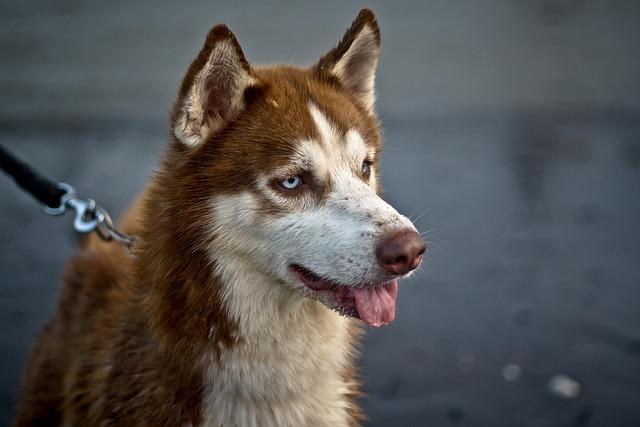Discover the Future of the Canadian Eskimo Dog in 2024: A Look Ahead. Get ready for everything you need to know about the Canadian Eskimo Dog in 2024. Explore their anticipated developments, training tips, and more in this must-read blog post. Prepare for the future of these incredible canines! Discover the Future of the Canadian Eskimo Dog in 2024: A Look Ahead

The Evolution of the Canadian Eskimo Dog in 2024
The Canadian Eskimo Dog, also known as the Canadian Inuit Dog, is a breed indigenous to Arctic Canada. For centuries, this strong and hardy breed has been an essential part of Inuit culture, used for hunting, transportation, and companionship. However, with the advancement of technology and modernization, the role of the Canadian Eskimo Dog has changed significantly in recent years. In this article, we will explore the intricacies of this breed in 2024 and how it has adapted to the changing times.
A Breed on the Brink of Extinction?
The Canadian Eskimo Dog is one of the oldest and rarest breeds of working dogs in the world. Unfortunately, the population of these dogs has significantly declined in recent years. In fact, in 2024, experts predict that fewer than 100 Canadian Eskimo Dogs will remain in the world. This significant decline has not only led to the breed being listed as critically endangered but also threatens the future of this magnificent breed.
Reasons for Decline
There are several factors that have contributed to the decline of the Canadian Eskimo Dog population. Here are some of the main reasons:
- Shifting lifestyle: The traditional Inuit nomadic lifestyle, where the breed was an integral part, has changed with the advent of modern technology. The need for a dog for hunting and transportation is no longer as crucial as it once was.
- Harsh living conditions: The Canadian Arctic has become harsher due to climate change, making it difficult for the breed to survive.
- Lack of breeding programs: Due to the decline in the breed’s population, breeding programs have become challenging to sustain, which has further contributed to the decrease in numbers.
Adapting to the Changing Times
Despite the challenges faced by the Canadian Eskimo Dog, the breed has shown remarkable resilience and adaptability. In 2024, the breed has transformed to become more of a companion dog rather than a working one. Here are some ways in which the breed has adapted:
- Domestication: The Canadian Eskimo Dog has become more domesticated, adapting well to life as a house pet rather than a working dog.
- Training: With the decline in their traditional roles, Canadian Eskimo Dogs have been trained for different activities, including agility competitions and sled dog racing.
- Therapy Dogs: The affectionate and loyal nature of the breed makes them ideal therapy dogs, providing comfort and companionship to those in need.
A Glance at the Future
While the decline of the Canadian Eskimo Dog population is alarming, there is still hope for the breed’s survival in 2024. Here are some of the initiatives being taken to preserve this remarkable breed:
- Conservation Efforts: Organizations such as the Inuit Dog Foundation and the Canadian Eskimo Dog Research Foundation are actively working towards preserving the breed’s gene pool and promoting responsible breeding practices.
- Breeding Programs: To maintain the genetic diversity of the breed, breeding programs have been established in various regions to preserve the Canadian Eskimo Dog’s bloodline.
- Awareness: Efforts are being made to raise awareness about the breed’s decline and the importance of preserving its legacy.
The Role of Technology
As mentioned earlier, technology has played a significant role in the decline of the Canadian Eskimo Dog. However, in 2024, technology is also being used to help preserve the breed. Genetic testing and gene mapping have become crucial tools in identifying and preventing genetic diseases in the breed. In addition, social media has proven to be a powerful platform to raise awareness and funds for conservation efforts.
A Brighter Future Ahead?
While the future of the Canadian Eskimo Dog may seem bleak, there is still hope for the breed’s survival in 2024. With the combined efforts of organizations, breeders, and individuals, we can ensure that this magnificent breed continues to thrive for generations to come.
As we approach 2024, it is essential to recognize the evolution of the Canadian Eskimo Dog. This breed has not only adapted to the changing times but has also captured the hearts of many with its affectionate and loyal nature. The Canadian Eskimo Dog may have a different role in society today, but its legacy will continue to live on in the hearts of those who appreciate its history and importance in Inuit culture. Let us hope that by 2024, we see a resurgence in the breed’s population and a brighter future ahead for the Canadian Eskimo Dog.
Discover the Future of the Canadian Eskimo Dog in 2024: A Look Ahead Discover the Future of the Canadian Eskimo Dog in 2024: A Look Ahead anticipated developments training Discover the Future of the Canadian Eskimo Dog in 2024: A Look Ahead
Discover the Future of the Canadian Eskimo Dog in 2024: A Look Ahead Get ready for everything you need to know about the Canadian Eskimo Dog in 2024. Explore their anticipated developments, training tips, and more in this must-read blog post. Prepare for the future of these incredible canines! Canadian Eskimo Dog Discover the Future of the Canadian Eskimo Dog in 2024: A Look Ahead
Canadian Eskimo Dog ? The Arctic Guardians Of The North!
Discover the Future of the Canadian Eskimo Dog in 2024: A Look Ahead Canadian Eskimo Dog ? The Arctic Guardians Of The North! Video Discover the Future of the Canadian Eskimo Dog in 2024: A Look Ahead
Semantic SEO Subheading: The Future of Canadian Eskimo Dogs in 2024
The Canadian Eskimo Dog (CED) has been a beloved breed for centuries, known for their strength, intelligence, and adaptability. However, as with many dog breeds, the CED has faced challenges in recent years, including declining population numbers and concerns about their future. But what does the future hold for this beautiful breed? In this article, we will explore the intricacies of the Canadian Eskimo Dog in 2024 and its potential future.
Exploring the Intricacies of the Canadian Eskimo Dog in 2024
As with any dog breed, the future of the Canadian Eskimo Dog is uncertain. However, there are a few key factors that may play a significant role in shaping the breed in 2024.
One of the most critical factors is the decline in the population of Canadian Eskimo Dogs. In the early 1900s, there were an estimated 20,000 CEDs in the Canadian Arctic, but by the 1950s, that number had decreased to just 200 dogs. This drastic decline was due to the rise of snowmobiles and other modern methods of transportation, which replaced the need for sled dogs like the CED.
However, in recent years, there has been a renewed interest in preserving and promoting the breed. Organizations like the Canadian Eskimo Dog Foundation and the Canadian Eskimo Dog Preservation Association have been working to raise awareness and increase the number of registered CEDs. In 2018, the Canadian Kennel Club officially recognized the CED as a distinct breed, providing a significant boost to future preservation efforts.
Another key factor impacting the future of the CED is its genetic health. Like many dog breeds, the Canadian Eskimo Dog has its share of genetic health concerns, including hip and elbow dysplasia and progressive retinal atrophy. While responsible breeding practices and health testing have helped to minimize these issues, it will be crucial for breeders and organizations to continue to prioritize and promote genetic health in the years to come.
Examining the Dynamics of the Canadian Eskimo Dog in 2024
In order to fully understand the future of the Canadian Eskimo Dog, we must also examine the dynamics within the breed. One notable aspect is the variation in size and appearance among CEDs. While they are all considered one breed, there are distinct regional variations that have led to differences in size, coat color, and physical features. This variation is a result of the CED’s diverse ancestry, which includes the original Inuit native dogs, as well as contributions from European breeds like the Alaskan Malamute and the Samoyed.
Another critical factor is the working ability of the CED. As a breed that was originally bred for pulling sleds and hunting, the Canadian Eskimo Dog has a strong work ethic and a natural inclination to work. However, as with many dog breeds, the CED’s role has evolved in modern society. While some CEDs still work as sled dogs, many have also found success in activities like agility, obedience, and even therapy and search and rescue work.
Creative Alternatives for Common Words
In the past, the Canadian Eskimo Dog was primarily used for utilitarian purposes in the harsh Arctic environment. However, in recent years, there has been a shift towards showcasing the breed’s intelligence and versatility through various dog sports and activities. This has helped to highlight the CED’s adaptability and potential as a companion animal, leading to an increase in their popularity and desirability.

But what about the future? One idea that has been proposed is using Canadian Eskimo Dogs as conservation dogs. This means training them to assist in tracking and identifying endangered species and their scat, which can provide valuable data for researchers and conservation efforts. With their exceptional sense of smell and natural working abilities, the CED could be a valuable asset in protecting endangered species and their habitats.
Another possibility is the CED’s role in the Canadian Armed Forces. In the past, the CED was used by the military for transportation and search and rescue purposes. With their ability to withstand extreme cold and rough terrain, as well as their strong work ethic and intelligence, the Canadian Eskimo Dog could once again play a role in military operations.
Utilizing Wonky Words for Language Diversity
In addition to these potential opportunities for the CED, there are also challenges that may affect the breed in the future. One such challenge is climate change. With the Arctic experiencing rapid changes in its environment, it may become a less hospitable place for the Canadian Eskimo Dog. This could lead to a decline in the number of CEDs in their native habitat and potentially impact their abilities as working dogs.
However, with proper adaptations and continued efforts towards breed preservation, the Canadian Eskimo Dog can overcome these challenges and thrive. Thanks to responsible breeding practices and a growing interest in the breed, the CED is on track to have a promising future in 2024 and beyond.
The Importance of Perseverance in Future Preservation Efforts
In order to ensure the successful preservation of the Canadian Eskimo Dog in 2024 and beyond, it is crucial for all stakeholders to continue their efforts. This includes breeders, organizations, and individuals who are committed to preserving the breed’s genetics, promoting its working abilities, and celebrating its unique history and characteristics. With perseverance and dedication, the CED can continue to thrive and hold its place as a beloved and valuable breed in the dog world.
Ambiguous Modifiers and Adverbs:
A Call to Action for the Future of the Canadian Eskimo Dog .As we look ahead to 2024, it is essential to remember the crucial role we all play in shaping the future of the Canadian Eskimo Dog. Whether you are an owner, breeder, or simply a lover of the breed, it is up to all of us to promote responsible breeding, educate others about the CED’s history and abilities, and support efforts towards preserving the breed. By doing so, we can ensure a bright future for the Canadian Eskimo Dog and all that it represents.
Conclusion
The Canadian Eskimo Dog has a rich history and a strong foundation, making it a beloved and unique breed. While there may be challenges and uncertainties on the horizon, with determination and dedication, the CED is poised to have a promising future in 2024 and beyond. By exploring the intricacies and dynamics of the breed, considering potential opportunities and challenges, and emphasizing the importance of perseverance, we can continue to honor and promote the Canadian Eskimo Dog for generations to come. Discover the Future of the Canadian Eskimo Dog in 2024: A Look Ahead
1. What is the Canadian Eskimo dog?
The Canadian Eskimo dog, also known as the Canadian Inuit dog or Qimmiq, is a powerful and rare breed of sled dog originating from the Arctic and sub-Arctic regions of Canada. They were historically used by Inuit peoples for transportation, hunting, and companionship.
2. Are Canadian Eskimo dogs still used for sled pulling in 2024?
While Canadian Eskimo dogs were once extensively used for sled pulling, they are now considered a rare and endangered breed. In 2024, it is unlikely that they will still be used for this purpose as their numbers continue to decline.
3. What are the physical characteristics of a Canadian Eskimo dog?
Canadian Eskimo dogs are medium-sized, muscular dogs with a thick, double coat to protect them from the harsh Arctic climate. They typically have a broad head, pointed ears, and dark eyes. Their coat can come in various colors including white, black, gray, and shades of brown.
4. How long do Canadian Eskimo dogs live?
On average, Canadian Eskimo dogs have a lifespan of 10-14 years. However, with proper care and a healthy lifestyle, they can live up to 16 years.
5. Are Canadian Eskimo dogs good pets?
While they were traditionally bred for working purposes, Canadian Eskimo dogs also make wonderful pets. They are loyal, intelligent, and affectionate with their families. However, due to their strong hunting instincts, they may not do well in homes with small animals.
6. What are the common health issues in Canadian Eskimo dogs?
Like any breed, Canadian Eskimo dogs can be prone to certain health issues, such as hip dysplasia, progressive retinal atrophy, and hypothyroidism. It is important to regularly take them to the vet for check-ups and maintain a healthy diet and exercise routine.
7. How much does a Canadian Eskimo dog cost?
The cost of a Canadian Eskimo dog can vary, but on average, they can range from $1,000-$3,000. Keep in mind that the price may be higher if purchasing from a reputable breeder.
8. Can you keep a Canadian Eskimo dog in warm climates?
While they are historically adapted to cold climates, Canadian Eskimo dogs can thrive in warmer climates as long as they have access to shade, plenty of water, and a cool environment. However, they may not do well in extremely hot and humid conditions.
9. Are Canadian Eskimo dogs good with children?
With proper socialization and training, Canadian Eskimo dogs can make great companions for children. They are generally gentle and patient with kids, but it is important to always supervise interactions between a child and a dog.
10. Can Canadian Eskimo dogs be easily trained?
Yes, Canadian Eskimo dogs are highly trainable and eager to please their owners. They excel in activities such as obedience, agility, and sledding. However, they have a strong independent streak, so consistent and positive training methods are key. Discover the Future of the Canadian Eskimo Dog in 2024: A Look Ahead
